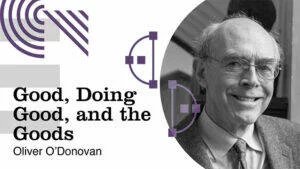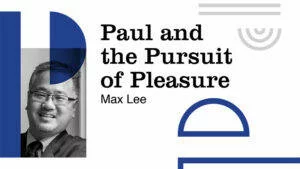Previous Sapientia symposia seem to analyze books on big-picture issues of science and religion. A new work on miracles by an eminent New Testament scholar would appear to fit this pattern well, but does it? The subtitle aptly indicates the work’s main focus: “God’s Presence and Power in Creation.” Johnson explains that he is not interested in focusing just on those texts in Scripture where, according to one definition of miracle, natural laws of cause and effect appear to be violated, though he does address them.
The majority of the volume is an exemplary sweep through the canon, showing that God in every era is at work, both in patterned and in surprising ways, infusing it with his activity. He reveals himself to people, speaks to them, influences, guides and protects them to enable the faith-filled believer to discern his existence, character and behavior, even if never disclosing himself so undeniably that all are compelled to believe.
Myth, Metaphor, Miracle?
I agree with all this. Among major, recent book-length works on biblical miracles I know of no others who take this precise approach. This is a wonderful gift to readers who may be used to thinking of a different collection of topics when they see Miracles as the title of a new book. Even so, I would love to probe Johnson’s take on the very things he has explicitly chosen not to elucidate. What does he think of miracles more traditionally defined? Did Jesus walk on water, or is this a myth or metaphor for some other kind of spiritual truth? Are people demon-possessed today and can Christians exorcise them, or must we understand this phenomenon as a psychosomatic illness better treated by the psychiatrist?
At numerous points, the generous reader senses that Johnson may allow for the rare supernatural healing and that he is not a cessationist with respect to the full range of spiritual gifts. But he clearly does not expect any of us to replicate Jesus’ distinctive manner of crossing the Sea of Galilee (nor, I expect, do we). None of the Gospels focuses on this creative form of locomotion anyway, but on the theophany with which God discloses himself in Christ. When Johnson offers his sample sermon on the Transfiguration, however, and speaks about Peter coming to perceive Jesus now “in the fullest sense of the term” as the Son of God, “sharing fully in the presence and power of God,” he comments:
Such experiences and insights need not have happened, though, in a single transporting moment. They may have occurred, and I think probably did occur, in ways closer to our own experience. The biblical writers shape those experiences and insights into narratives that reveal the truth within them. In stories, such significance can only be done with bells and whistles, or if you prefer, clouds and flames, that proclaim, “Look, this is God at work” (p. 291).
At this point, I would love to learn how he distinguishes his interpretation from Rudolf Bultmann’s famous program of demythologizing Scripture’s miracles, which dominated so much of twentieth-century New Testament scholarship.
Matthean Miracles Divided by Three
A fair review should nevertheless evaluate what authors set out to do, not what they didn’t. So let me turn to Johnson’s treatment of miracles in Matthew, the one Gospel for which I have written a formal commentary and thus, arguably, have the most expertise. Has he elucidated Matthew’s distinctive and characteristic emphases, as was his goal?Johnson divides the miracles into “exorcisms,” “healings,” and “power over creation.” While not guaranteeing the same results for other parts of the Bible, such analysis can at least give us a glimpse into Johnson’s approach and the quality of study we might expect when we read about miracles in each of the other parts of Scripture.
An introductory section deals with some of Matthew’s redactional tendencies in general. Most relevant for the miracles is his penchant for abbreviating Mark, sometimes drastically and often in order to focus attention more exclusively on Christology (see esp. the treatment in Matt. 8:28-34 of Mark’s “Gerasene demoniac”). While here Matthew “loses the dimension of human alienation and restoration” (p. 215) that Mark highlights, he does in other places, give greater credit to human faith (most notably in his five unique uses of oligopistoi/ia (people with at least a “little faith”).
Next Johnson divides the miracles into “exorcisms,” “healings,” and “power over creation.” Among the exorcisms, he notes the account of the Canaanite woman’s daughter in 15:21-28 as an excellent example of where Matthew adds Jesus’ praise of her faith (v. 28). He observes that 9:32-34, which seems unique to Matthew, could have come from Mark 7:31-37 but if so Matthew has turned a healing into an exorcism besides removing all of Mark’s characteristic detail.With the miracles of power over creation, we come to some of the most interesting redactional distinctives. It is hard to tell if that is Johnson’s way of saying this view is less likely; I would want to suggest it is most improbable. Conversely, of course, it is entirely permissible for Matthew to call what is already an exorcism story a healing as well (12:22-24).
Concerning healings, Johnson remarks that Matthew twice has Jesus heal two blind men (9:27-31; 20:29-34), parallel to the two demonized men by the lake—8:28). Michael Licona has recently stressed that Plutarch, like other ancient historians and biographers, often “spotlights” a single individual in one of his “lives” where a parallel account has more than one without any sense of contradiction. This is only to be expected if one person is a more prominent one (e.g., the speaker). Johnson does not let on whether he would accept this explanation or not. He does correctly stress Matthew’s emphasis on the fulfillment of Scripture. For the healing miracles, the key verse appears in 8:17 (citing Isa. 53:4). Matthew ties Jesus feeding the multitudes with his ministry of healing as well (15:29-31) and stresses the link between Jesus’ healings and his preaching and teaching about the kingdom, in each instance to highlight Jesus’ authority and identity (4:23; 9:35).
With the miracles of power over creation, we come to some of the most interesting redactional distinctives. Matthew’s reversal of the order of Jesus’ rebuke to the disciples and his stilling the storm, along with changing “no faith” to “little faith” (Matt. 8:26; cf. Mark 4:39-40) was the passage that spawned Matthean redaction criticism to begin with in the writings of Gunther Bornkamm. Still, the difference between the texts must not be overestimated; calling people “men of little faith” is still not a compliment! So, too, it is hard to know what to make of Peter’s unique role in temporarily imitating Jesus’ water-walking miracle (Matt. 14:28-31). Johnson remains neutral by simply referring to Matthew’s “complex” portrait of Peter. In each of the five unique insertions of Peter into his narrative in chapters 14-18, a case can in fact be made that Peter is being portrayed as more dull-witted than exemplary.
Biblical Theology of Miracles
More so than many interpreters, Johnson recognizes that the famous coin in the fish’s mouth (Matt. 17:27) is not a miracle narrative at all, just a command to Peter about what he should do and what will happen if he does it. But he concludes that “this is the one (promised) miracle in the Gospels that appears most arbitrary, a pure display of power over creation” (p. 222). That very distinctive might be another clue (besides the form)To the extent that the rest of the book contains similarly well-chosen material, and I judge that it usually does, we have here the makings of a wonderful biblical theology of miracles. that Matthew in fact is not narrating something that Peter actually did, or that, if he did, that it had a more symbolic meaning that Johnson has not suggested. The distinctive features surrounding Matthew’s resurrection account do not resolve the ambiguity of the shorter, probably original ending of Mark, because the women still combine fear and joy (Matt. 28:8). Differently, Matthew has not “transformed” Mark’s “young man” into an “angel” (p. 223) so much as he has identified one standard Jewish way of identifying a young man dressed in a white garment.
It could have been illuminating for Johnson to note how Matthew collects ten miracles in nine pericopae spanning chapters 8-9 with a very symmetrical structure of three triads that focus the greatest attention on the particularly spectacular miracles in 8:28-9:8. This could have reinforced Johnson’s point about the role of miracles in underlining Jesus’ authority, since Matthew creates an inclusio with 4:23 and 9:35 framing chapters 5-9, with 5-7 illustrating Jesus’ paradigmatic teaching and preaching, and chapters 8-9 providing paradigmatic healings and related miracles. Overall, though, one comes away from Johnson’s treatment with a reliable collection of Matthew’s redactional distinctives.
To the extent that the rest of the book contains similarly well-chosen material, and I judge that it usually does, we have here the makings of a wonderful biblical theology of miracles. Whether that is what typical readers hope to receive or even think they will receive when perusing a volume in this topical series designed to supplement the Interpretation commentary series is another matter, but one outside the scope of this review. When judged by what Johnson attempted rather than by what he did not, this is a splendid introduction to the vast array of biblical content that impinges, in the broadest sense, on the biblical category of miracle.








Comments
Be the first one to make a comment!